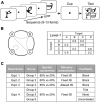Flexible structure learning under uncertainty
- PMID: 37599995
- PMCID: PMC10437075
- DOI: 10.3389/fnins.2023.1195388
Flexible structure learning under uncertainty
Abstract
Experience is known to facilitate our ability to interpret sequences of events and make predictions about the future by extracting temporal regularities in our environments. Here, we ask whether uncertainty in dynamic environments affects our ability to learn predictive structures. We exposed participants to sequences of symbols determined by first-order Markov models and asked them to indicate which symbol they expected to follow each sequence. We introduced uncertainty in this prediction task by manipulating the: (a) probability of symbol co-occurrence, (b) stimulus presentation rate. Further, we manipulated feedback, as it is known to play a key role in resolving uncertainty. Our results demonstrate that increasing the similarity in the probabilities of symbol co-occurrence impaired performance on the prediction task. In contrast, increasing uncertainty in stimulus presentation rate by introducing temporal jitter resulted in participants adopting a strategy closer to probability maximization than matching and improving in the prediction tasks. Next, we show that feedback plays a key role in learning predictive statistics. Trial-by-trial feedback yielded stronger improvement than block feedback or no feedback; that is, participants adopted a strategy closer to probability maximization and showed stronger improvement when trained with trial-by-trial feedback. Further, correlating individual strategy with learning performance showed better performance in structure learning for observers who adopted a strategy closer to maximization. Our results indicate that executive cognitive functions (i.e., selective attention) may account for this individual variability in strategy and structure learning ability. Taken together, our results provide evidence for flexible structure learning; individuals adapt their decision strategy closer to probability maximization, reducing uncertainty in temporal sequences and improving their ability to learn predictive statistics in variable environments.
Keywords: decision strategy; perceptual decisions; structure learning; uncertainty; vision.
Copyright © 2023 Wang, Gates, Shen, Tino and Kourtzi.
Conflict of interest statement
The authors declare that the research was conducted in the absence of any commercial or financial relationships that could be construed as a potential conflict of interest.
Figures







Similar articles
-
Learning predictive statistics from temporal sequences: Dynamics and strategies.J Vis. 2017 Oct 1;17(12):1. doi: 10.1167/17.12.1. J Vis. 2017. PMID: 28973111 Free PMC article.
-
Learning-induced uncertainty reduction in perceptual decisions is task-dependent.Front Hum Neurosci. 2014 May 7;8:282. doi: 10.3389/fnhum.2014.00282. eCollection 2014. Front Hum Neurosci. 2014. PMID: 24847237 Free PMC article.
-
Optimal temporal risk assessment.Front Integr Neurosci. 2011 Sep 27;5:56. doi: 10.3389/fnint.2011.00056. eCollection 2011. Front Integr Neurosci. 2011. PMID: 21991250 Free PMC article.
-
Assessing evidence accumulation and rule learning in humans with an online game.J Neurophysiol. 2023 Jan 1;129(1):131-143. doi: 10.1152/jn.00124.2022. Epub 2022 Dec 7. J Neurophysiol. 2023. PMID: 36475830
-
On the joys of perceiving: Affect as feedback for perceptual predictions.Acta Psychol (Amst). 2016 Sep;169:1-10. doi: 10.1016/j.actpsy.2016.05.005. Epub 2016 May 16. Acta Psychol (Amst). 2016. PMID: 27195963 Review.
Cited by
-
An Exact Theory of Causal Emergence for Linear Stochastic Iteration Systems.Entropy (Basel). 2024 Jul 23;26(8):618. doi: 10.3390/e26080618. Entropy (Basel). 2024. PMID: 39202088 Free PMC article.
References
-
- Ambrus G. G., Vékony T., Janacsek K., Trimborn A. B. C., Kovács G., Nemeth D. (2020). When less is more: Enhanced statistical learning of non-adjacent dependencies after disruption of bilateral DLPFC. J. Mem. Lang. 114:104144. 10.1016/j.jml.2020.104144 - DOI
LinkOut - more resources
Full Text Sources

